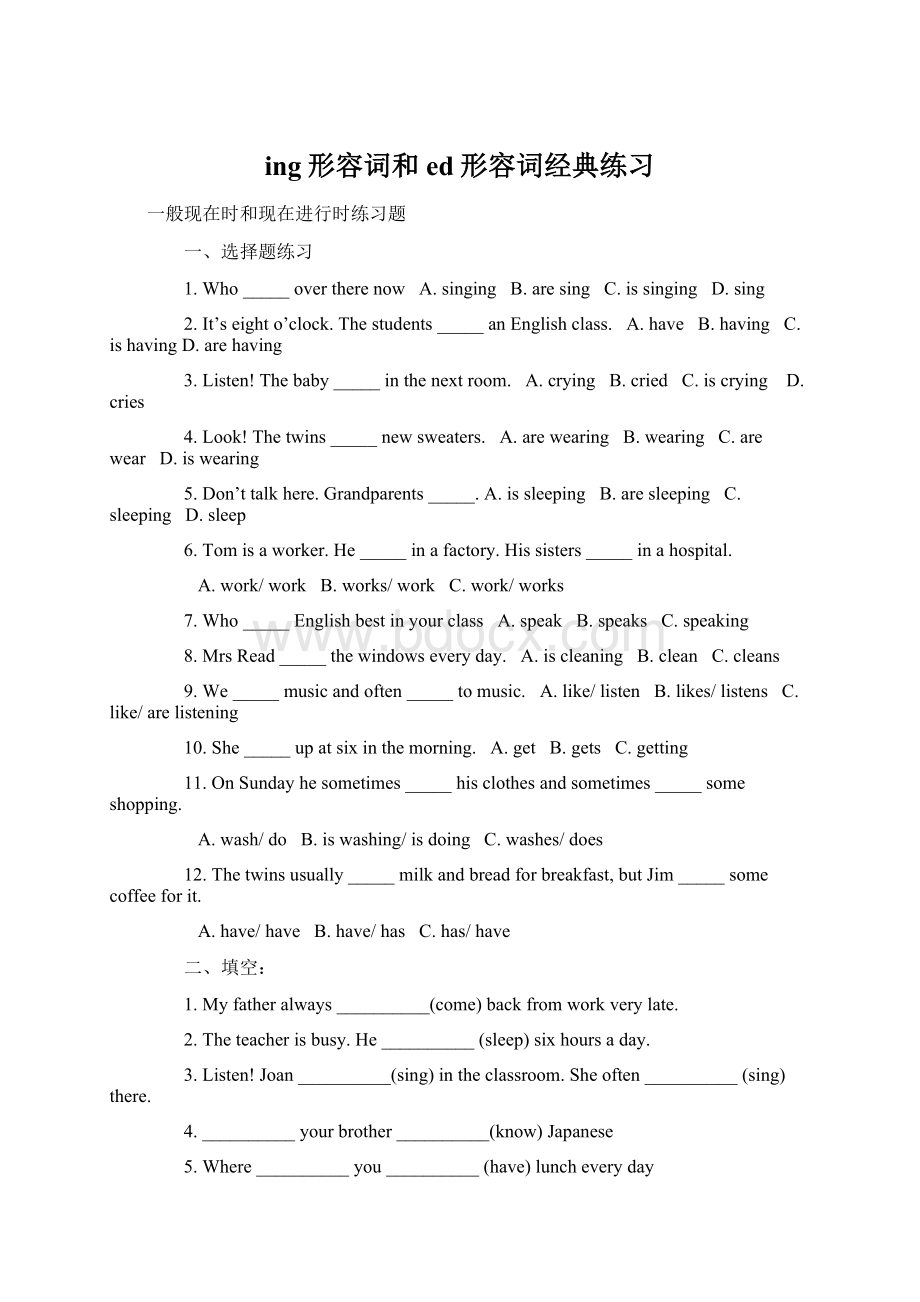 ing形容词和ed形容词经典练习Word文档下载推荐.docx
ing形容词和ed形容词经典练习Word文档下载推荐.docx
- 文档编号:20236574
- 上传时间:2023-01-21
- 格式:DOCX
- 页数:15
- 大小:26.51KB
ing形容词和ed形容词经典练习Word文档下载推荐.docx
《ing形容词和ed形容词经典练习Word文档下载推荐.docx》由会员分享,可在线阅读,更多相关《ing形容词和ed形容词经典练习Word文档下载推荐.docx(15页珍藏版)》请在冰豆网上搜索。

A.iscleaning
B.clean
C.cleans
9.We_____musicandoften_____tomusic.
A.like/listen
B.likes/listens
C.like/arelistening
10.She_____upatsixinthemorning.
A.get
B.gets
C.getting
11.OnSundayhesometimes_____hisclothesandsometimes_____someshopping.
A.wash/do
B.iswashing/isdoing
C.washes/does
12.Thetwinsusually_____milkandbreadforbreakfast,butJim_____somecoffeeforit.
A.have/have
B.have/has
C.has/have
二、填空:
1.Myfatheralways__________(come)backfromworkverylate.
2.Theteacherisbusy.He__________(sleep)sixhoursaday.
Joan__________(sing)intheclassroom.Sheoften__________(sing)there.
4.__________yourbrother__________(know)Japanese
5.Where__________you__________(have)luncheveryday
6.Thegirl__________(like)wearingaskirt.Look!
She__________(wear)aredskirttoday.
三、写出下列动词的现在分词形式
1.work___________
sing__________
play__________
study__________
2.dance__________
have__________
write__________
take__________
3.run__________
sit__________
shop__________
swim__________
4.lie__________
四、写出下列动词的第三人称单数形式
1.work__________
read__________
clean__________
write__________
2.teach__________
wash__________
guess__________
watch__________
do___________
fly__________
cry__________
play_________
一
用括号内所给动词的-ed形式或-ing形式填空
1.
The
children
were
after
the
trip.
(tire)
2.
trip
was.
3.
children
went
to
bed
early
after
4.
trip
lasted
a
whole
day.
5.
made
children.
(tire)
6.
bad
weather
trip.
7.
Tom’s
parents
are
____
at
his
results
of
exams.(disappoint)
8.
and
angry,
he
left
meeting-room.
(disappoint)
9.
It
is
that
didn’t
pass
examination.(disappoint)
10.
When
hearing
thenews
that
Michael
Jackson
passed
away,
they
wereto
look
each
other.
(surprise)
11.
He
was
about
son.
(worry)
二、选择题
()1.The
little
boy
isnotgetting
on
well
in
maths
and
worse
still,
even
unwilling
go
school.
With
her
son
_____,
she
feels
very
______.
A.
disappointing;
worrying
B.
worried
C.
disappointed;
D.
()2.
After
Anti-terrorist
War,
American
soldiers
returned
home,
safe
but
tired
safely
tiring
D.
()3.
As
we
all
know,
typing
______
job
heart.
tired;
tiring;
()4._____
do
you
think
your
English
teacher
Is
_______
What,
interesting
interested
How,
V-ed形式的用法
过去分词作定语
I.基本了解
1.V-ed形式的构成
V-ed形式有规则变化和不规则变化之分。
规则的V-ed形式由动词原形加词尾-ed构成,不规则的V-ed形式情况各异。
2.V-ed形式的意义
及物动词的V-ed形式表示被动和完成,不及物动词的V-ed形式仅表示完成。
[自填助记]
a(n) cup一个破杯子the novel出版了的小说
a(n) country发达国家the leaves落叶
[Key]broken;
published;
developed;
fallen
II.V-ed形式作定语时的位置及意义
1.位置
单个V-ed形式作定语时要放在被修饰的词语之前,V-ed形式短语作定语时要放在被修饰的词语之后。
①Heis__________________________________(一名退休工人).
②_________________________________(那个丢失的孩子)wasfoundatlast.
③__________________________(那个在电影院里丢失的孩子)wasfoundatlast.
④Wearegoingtotalkabouttheproblem__________________(上次会上讨论的).
[Key]
①aretiredworker②Thelostchild
③Thechildlostinthecinema④discussedatthelastmeeting
2.意义
(1)V-ed形式作定语,意义上相当于一个定语从句。
(2)及物动词的V-ed形式和逻辑主语(即它所修饰的名词)之间是被动关系,强调动作已完成,可以替换为一个谓语动词是被动语态的定语从句。
(3)不及物动词的V-ed形式和逻辑主语之间是主动关系(即只说明逻辑主语所处的状态和具有的特点等),强调动作已完成,可以替换为一个谓语动词是主动语态的定语从句。
①Thehouse,builtahundredyearsago,stoodstillaftertheearthquake.
=Thehouse,_____________ahundredyearsago,stoodstillaftertheearthquake.
②Therearealotoffallenleavesinautumn.
=Therearealotofleaves_____________inautumn.
[Key]①whichwasbuilt②which/thathavefallen
[高考链接]
1.Forbreakfastheonlydrinksjuicefromfreshfruit onhisownfarm.[2009年北京卷]
A.grownB.beinggrownC.tobegrownD.togrow
2.Thetrees inthestormhavebeenmovedofftheroad.[2008年湖南卷]
A.beingblowndownB.blowndownC.blowingdownDtoblowdown
3.Itisoneofthefunniestthings ontheInternetsofarthisyear.[2008年浙江卷]
A.findingB.beingfoundC.tofindD.found
4.TheTownHall inthe1800’swasthemostdistinguishedbuildingatthattime.[2007年上海卷]
A.tobecompletedB.havingbeencompleted
C.CompletedD.beingcompleted
5.“Things nevercomeagain!
”Icouldn’thelptalkingtomyself.[2007年湖南卷]
A.lostB.LosingC.toloseD.havelost
[Key]2.B3.D4.C5.A
过去分词作宾语补足语
内容简介:
过去分词作宾补,表示被动或完成意义。
过去分词与宾语之间通常存在逻辑上的动宾关系。
过去分词作宾补常用于以下四种情况:
一、用在感官动词see,watch,notice,find,observe,catch,hear,feel等后面作宾补。
如:
Shesawthewoundedmancarriedintothehospital.
她看到那个受伤的男人被抬进了医院。
【考例点击】
InthedreamPetersawhimself byafiercewolf,andhewokesuddenlywithastart.(2006上海卷)
A.chasedB.tobechasedC.bechasedD.havingbeenchased【A】
【拓展】非谓语动词用在感官动词后作宾补的区别:
不定式(不带to)常表示动作已结束,强调动作的全过程;
现在分词表示正在进行的动作,强调当时的情景,为部分过程;
过去分词与宾语之间为被动关系或表示动作已完成。
Afteraknockatthedoor,thechildheardhismother’svoice him.(2007上海春)
A.callingB.calledC.beingcalledD.tocall【A】
二、用在使役动词have,make,get,keep,leave等后面作宾补。
Hemanagedtogetthetaskfinishedontime.他设法按时完成了任务。
JennyhopesthatMr.SmithwillsuggestagoodwaytohaveherwrittenEnglish inashortperiod.(2007福建卷)
A.improvedB.ImprovingC.toimproveD.Improve【A】
【特别提醒】
(1)在“have+宾语+宾补”结构中,充当宾补的有do,doing和done。
do表示主动,动作可能发生;
doing表示主动,动作在持续;
havesth.done请别人来做某事或遭遇到某情况。
Thedirectorhadherassistant somehotdogsforthemeeting.(2008全国II卷)
A.pickedupB.picksupC.pickupD.pickingup【C】
(2)在“make+宾语+宾补”结构中用do或done而不用doing作宾补。
Myparentshavealwaysmademe aboutmyself,evenwhenIwastwelve.
(2007江苏卷)
A.feelingwellB.feelinggoodC.feelwellD.feelgood【D】
(3)“keep/leave+宾语+宾补”,宾补由过去分词、现在分词等充当。
Theyusecomputerstokeepthetraffic smoothly.(2009全国II卷)
A.beingrunB.runC.torunD.running【D】
三、用在order,want,wish,expect等表示“希望、要求”的动词后面作宾补。
Shewantsherpaintings inthegallery,butwedon’tthinktheywouldbevery
popular.(2007上海春)
A.displayB.todisplayC.displayingD.displayed【D】
【拓展】此类动词后跟todo和done作宾补。
todo表主动,done表被动。
四、在“with复合结构”中作宾补。
Thedayendedwithnothingsettled.
那一天什么也没解决就结束了。
Johnreceivedaninvitationtodinner,andwithhiswork ,hegladlyacceptedit.(2007安徽卷)
A.finishedB.finishingC.havingfinishedD.wasfinished
【A】
【拓展】在with复合结构中,不定式表示尚未发生的动作,现在分词表示主动关
系,过去分词表示被动关系。
—Comeon,pleasegivemesomeideasabouttheproject.
—Sorry.Withsomuchwork mymind,Ialmostbreakdown.(2007福建卷)
A.filledB.fillingC.tofillD.beingfilled【B】
过去分词作定语、表语
一、过去分词作定语:
1.Thegroundiscoveredwithfallenleaves.
2.Peopletodaytendtochoosevegetablesgrownwithoutchemicals.
3.Themoneyraisedattheeveningwillbesenttotheearthquakesurvivorsassoonaspossible.
通过对三个例句的观察,我们可以发现过去分词作定语的主要知识点:
(1)单个的过去分词作定语一般置于被修饰的名词之前。
cookedfood,boiledwater,friedeggs,aforcedsmile...
过去分词短语作定语则置于被修饰的名词之后。
problemsleftoverbyhistory,awomandressedingreen...
(2)及物动词的过去分词表示“被动”或“被动并结束了的动作”,如:
vegetablesgrownwithoutchemicals,arepairedcar…
不及物动词的过去分词只表示“动作发生在谓语动词之前”或“动作已完成、已结束”,不表示被动。
fallenleaves,fadedflowers,therisensun…
(3)及物动词的过去分词可以扩展为一个谓语动词是被动语态的定语从句。
vegetablesgrownwithoutchemicals=vegetableswhicharegrownwithoutchemicals
不及物动词的过去分词可以扩展为一个谓语动词是主动语态的定语从句。
fallenleaves=leavesthathavefallen
二、过去分词作表语:
1.TheyoungNBAbasketballkingJamesismarried.
Weareexcitedtohearthegoodnews.
2.Thewindowofmyroomisbroken.我房间的窗户是坏的。
(表主语所处状态)
Thewindowofmyroomisbrokenbymynaughtycousin.
我房间的窗户是被淘气的表弟打坏的。
(表被动)
3.Don’tbesodisappointed.(表主语主观上觉得失望的心理感受)
Theresultoftheexamisdisappointing.(表主语客观上具有令人失望的性质特征)通过对这三组例句的观察,我们可以发现过去分词作表语的主要特征:
(1)过去分词作表语表示主语所处状态或主观心理感受,相当于形容词的作用。
如例句1中的married(已婚的),excited(激动的)。
此类常见词还有:
表状态:
addicted,broken,gone,lost,seated,absorbed,dressed,separated,engaged…表主观心理感受:
excited,moved,puzzled,disappointed,surprised,frightened…
(2)过去分词作表语还需把握好两点,即区分表示“主语所处状态”与表示被动语态的过去分词;
区分v-ed形容词表“主观心理感受”与v-ing形容词表“客观上具有……的性质特征”。
三、高考直击:
例1Thetrees inthestormhavebeenmovedofftheroad.(2008湖南卷)
A.beingblowndownB.blowndownC.blowingdownD.toblowdown
解析:
B。
本题考查非谓语动词。
根据题干中havebeenmovedofftheroad可知,树是已被吹倒的,blowndown作定语表示动作已发生,且与被修饰词Thetrees是被动关系。
例2TheTownHall inthe1800’swasthemostdistinguishedbuildingatthattime.(2007上海卷)
C.completedD.beingcompleted
C。
过去分词作定语表示被动和已经完成的动作。
根据时间状语inthe1800’s可判断出要用过去分词作定语。
不定式的被动式作定语表示将要被做的事。
现在分词作定语表示正在被做的事
- 配套讲稿:
如PPT文件的首页显示word图标,表示该PPT已包含配套word讲稿。双击word图标可打开word文档。
- 特殊限制:
部分文档作品中含有的国旗、国徽等图片,仅作为作品整体效果示例展示,禁止商用。设计者仅对作品中独创性部分享有著作权。
- 关 键 词:
- ing 形容词 ed 经典 练习
 冰豆网所有资源均是用户自行上传分享,仅供网友学习交流,未经上传用户书面授权,请勿作他用。
冰豆网所有资源均是用户自行上传分享,仅供网友学习交流,未经上传用户书面授权,请勿作他用。


 对中国城市家庭的教育投资行为的理论和实证研究.docx
对中国城市家庭的教育投资行为的理论和实证研究.docx
